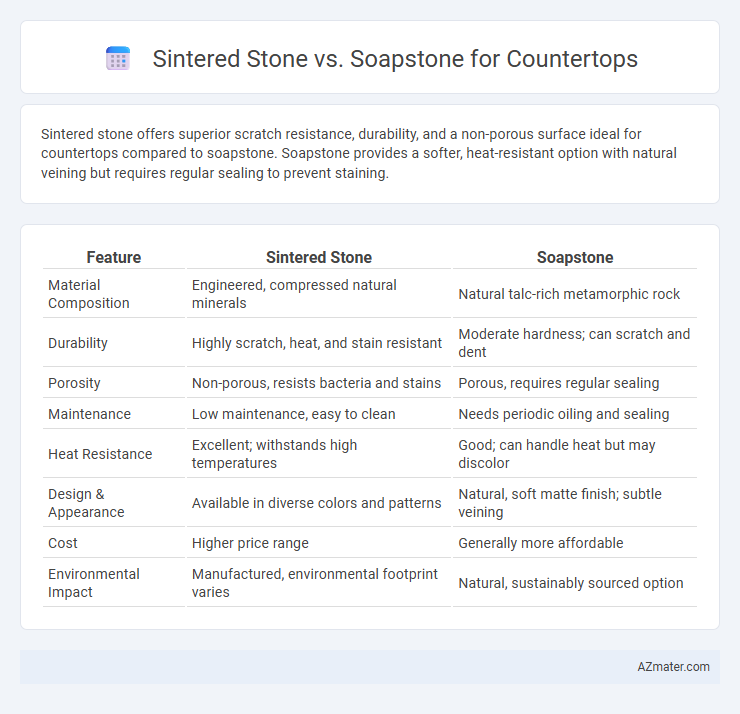Sintered stone offers superior scratch resistance, durability, and a non-porous surface ideal for countertops compared to soapstone. Soapstone provides a softer, heat-resistant option with natural veining but requires regular sealing to prevent staining.
Table of Comparison
| Feature | Sintered Stone | Soapstone |
|---|---|---|
| Material Composition | Engineered, compressed natural minerals | Natural talc-rich metamorphic rock |
| Durability | Highly scratch, heat, and stain resistant | Moderate hardness; can scratch and dent |
| Porosity | Non-porous, resists bacteria and stains | Porous, requires regular sealing |
| Maintenance | Low maintenance, easy to clean | Needs periodic oiling and sealing |
| Heat Resistance | Excellent; withstands high temperatures | Good; can handle heat but may discolor |
| Design & Appearance | Available in diverse colors and patterns | Natural, soft matte finish; subtle veining |
| Cost | Higher price range | Generally more affordable |
| Environmental Impact | Manufactured, environmental footprint varies | Natural, sustainably sourced option |
Introduction to Sintered Stone and Soapstone
Sintered stone is an engineered material made by compressing natural minerals under extreme heat and pressure, resulting in a highly durable, non-porous surface resistant to scratches, stains, and heat. Soapstone, a natural metamorphic rock composed primarily of talc, offers a smooth, heat-resistant, and non-porous surface with unique veining and a soft, matte finish that develops a rich patina over time. Both materials are popular choices for countertops, each providing distinct aesthetic and performance benefits suited for various kitchen and bathroom applications.
Material Composition and Properties
Sintered stone countertops are engineered from natural minerals like quartz, feldspar, and silica, fused under extreme heat and pressure to create a dense, non-porous surface resistant to scratches, stains, and heat. Soapstone, a natural metamorphic rock primarily composed of talc, offers exceptional heat resistance and a softer, slightly porous surface prone to develop a unique patina over time. The durability and maintenance needs differ significantly, with sintered stone providing a more uniform and resilient finish compared to the natural variation and softness of soapstone.
Aesthetic and Design Options
Sintered stone offers a wide range of colors, patterns, and finishes that mimic natural materials like marble and granite, making it highly versatile for modern and contemporary kitchen designs. Soapstone, with its smooth, matte finish and unique veining, provides a warm, rustic aesthetic that deepens over time, ideal for traditional and farmhouse styles. Both materials are durable, but sintered stone's intense pigmentation and resistance to fading ensure long-lasting vibrant aesthetics for diverse design preferences.
Durability and Scratch Resistance
Sintered stone countertops offer exceptional durability and scratch resistance due to their high-density composition formed through intense heat and pressure, making them highly resistant to chipping and abrasion. Soapstone, while naturally dense and resistant to heat, is softer and more prone to scratching and etching, requiring periodic oiling to maintain its surface integrity. For long-term resilience in high-traffic kitchen environments, sintered stone outperforms soapstone in maintaining a pristine, scratch-free finish.
Heat and Stain Resistance
Sintered stone offers superior heat resistance, withstanding temperatures up to 1,200degF without damage, making it ideal for kitchen countertops exposed to hot pots and pans. Soapstone also exhibits excellent heat resistance, tolerating direct heat well, but it is more porous and therefore less stain-resistant, requiring regular sealing to prevent discoloration from oils and acids. In contrast, sintered stone is highly non-porous and stain-resistant, providing a low-maintenance surface that resists staining from common kitchen substances like wine, coffee, and oils.
Maintenance and Cleaning Requirements
Sintered stone countertops require minimal maintenance due to their non-porous surface, making them resistant to stains, scratches, and heat, while cleaning only demands a mild detergent and water. Soapstone requires regular oiling or waxing to maintain its rich color and prevent surface oxidation, although it is naturally resistant to bacteria and stains. Both materials benefit from gentle cleaning routines, but sintered stone offers greater convenience with its low upkeep needs.
Cost Comparison and Value
Sintered stone countertops typically cost between $50 to $100 per square foot, offering superior durability, scratch resistance, and heat tolerance compared to soapstone, which ranges from $70 to $90 per square foot. While soapstone presents a natural, classic aesthetic with easier maintenance, sintered stone's resistance to stains and fading often translates to greater long-term value despite its initial price variance. Homeowners prioritizing longevity and investment return generally find sintered stone delivers better cost-effectiveness over time.
Installation Process and Considerations
Sintered stone countertops require professional installation due to their heavy weight and need for specialized cutting tools, ensuring precise fitting and durability. Soapstone, being softer, allows for easier DIY installation with basic tools but demands careful handling to avoid chipping or scratching during placement. Both materials require level surfaces and proper support, but sintered stone's rigidity offers greater resistance to heat and stains, influencing countertop framing and sealing methods.
Environmental Impact and Sustainability
Sintered stone countertops exhibit high environmental sustainability due to their manufacturing process, which uses natural minerals fused at extreme heat without harmful resins, resulting in a durable, non-porous surface that resists staining and requires no chemical sealants. Soapstone, a natural metamorphic rock, offers excellent eco-friendliness through minimal processing and exceptional longevity, often sourced locally to reduce carbon footprint, though it requires periodic oiling for maintenance that involves natural oils. Both materials are recyclable and have low environmental impact, but sintered stone's engineered production allows for optimized resource use, potentially making it a more sustainable choice in large-scale commercial applications.
Final Verdict: Choosing the Best Countertop Material
Sintered stone offers superior durability, scratch resistance, and a wide range of colors and patterns, making it ideal for high-traffic kitchen countertops. Soapstone provides natural heat resistance, chemical resistance, and a unique, smooth texture that develops a patina over time, preferred for rustic or traditional designs. For long-term performance and versatility, sintered stone is the best choice, while soapstone suits those valuing natural aesthetics and a softer, warm feel.

Infographic: Sintered stone vs Soapstone for Countertop
 azmater.com
azmater.com